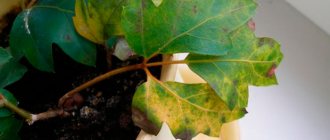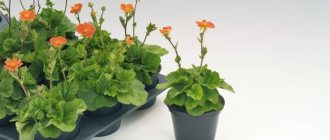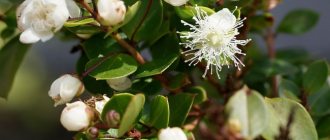2776
Myrtle (Myrtus) is an evergreen woody shrub with pronounced branching and small flowers of white or pink color. It is valued by modern florists for its decorative properties and ease of cultivation. The leaves of the tree are a powerful source of phytoncides that mercilessly kill pathogenic bacteria, and the flowers are a reservoir with a delicate aroma. Myrtle responds to care at home with abundant flowering and rapid growth.
Blooming at the height of the season
Beneficial properties and harm of myrtle
Myrtus is a medicinal plant whose beneficial properties are used in medicine.
- Essential oils exuded from the leaves are natural phytoncides that disinfect the surrounding air.
- An astringent and bactericidal effect helps relieve inflammation and heal wounds.
- Increases body tone, improves immunity.
- Helps with skin diseases: dermatitis, psoriasis; cosmetology.
- Stimulates the nervous system.
In addition to its beneficial properties, the flower can cause harm to humans:
- It is not recommended to place indoor myrtle in the bedroom - its pine aroma can cause insomnia and headaches.
- Medicines based on myrtle have a tonic effect, so they are not used before bedtime.
- The use of drugs in children and pregnant women is contraindicated.
How to save a plant?
First of all, you need to find the “golden mean” and water the myrtle in sufficient quantities. It is important not to overdo it, but also not to skimp on water if necessary. If there is not enough moisture, then the pot of myrtle can be dipped in a container of liquid for a few minutes. Through the drainage holes, water will penetrate to the roots, which will speed up the plant’s recovery process. After this, you need to place the pot on a tray so that the excess water drains, the roots do not rot and the myrtle does not dry out again.
How to revive a plant if you used too much liquid when watering, you need to replant the plant in new, dry soil as soon as possible. The shrub is removed from the old substrate and the roots are washed in water. After this, the plant is carefully examined, mercilessly cutting off the roots on which rot has appeared. Then the myrtle is transplanted into another soil. The first time after changing the substrate, watering should not be carried out.
The most popular types and varieties of myrtle
The following types of myrtle are kept indoors. Photo below.
Common myrtle
It has a short trunk covered with scaly, peeling bark. The leaves are brilliantly located opposite each other. The flowers are white with long yellow stamens protruding beyond the corolla.
At home, both the botanical species and varieties of common myrtle are grown.
The following varieties are most commonly found.
Tarentina
A low-growing variety characterized by dwarf size and abundant flowering.
Variegata
The leaves differ in color; they are variegated, green and white.
Chilean myrtle (Luma apiculata)
This species is represented by slowly growing trees reaching 10 - 20 meters in height. The trunks are twisted, with smooth bark. The berries of Chilean myrtle are edible and have medicinal properties, which is why they are used in medicine.
Dwarf forms are grown as indoor plants.
Glanleam Gold
Variegated form of Chilean myrtle. It is small in size.
Incorrect temperature
When growing shrubs, you need to pay special attention to temperature conditions. If myrtle leaves have dried out, perhaps the reason lies in incorrect temperature conditions. Remember: this plant must be kept at average temperatures. In summer they should be from +17 to +24 °C, and in winter, when the myrtle goes into a dormant state, from +10 to +12 °C. If the plant is kept in a room with higher temperatures during cold times, its leaves may wilt.
How to care for myrtle
The myrtle tree is quite picky in its content. Therefore, for successful growth, he is provided with proper care at home.
The soil
The plant prefers soil with high acidity. The mixture consists of the following components:
- turf land;
- compost soil or manure humus;
- peat;
- coarse sand.
All parts are taken in equal quantities.
This substrate is suitable for both adult plants and young seedlings.
Watering
- Water the plantings in a timely manner - even short-term drying out of the soil can trigger the shedding of leaves. If this happens, do not worry too much - the tree will grow again.
- Adding hydrogel to the soil will allow the soil to better retain moisture.
- It is useful to alternate watering with regular soft water and water acidified with lemon juice. To prepare the solution, add 2-3 drops of lemon juice to 1 liter of water.
- The home bush responds gratefully to spraying and cool showers.
Lighting, temperature
- The culture feels most comfortable in bright light, at moderate temperatures, about 18 - 23 C. The plant is covered from the scorching sun to prevent overheating. In summer it is taken out into the open air.
- The ideal option for keeping an indoor tree is a warm loggia or a bright, unheated room.
- Sometimes when Myrtus dries out, it is enough to take it into a cooler room to make it feel better.
- In winter, it is provided with a temperature of about 10 - 12 C. Watering for this period is limited, but without drying out the earthen coma.
Features of care
Temperature: in winter the temperature should not exceed 13°C.
Lighting: prefers good lighting, but can also grow in the shade.
Humidity: in summer, myrtle needs abundant watering, in winter - sparingly. It is advisable to spray regularly, at least every other day.
Soil: equal parts of turf and leaf soil, humus, peat and sand.
Nutrition: in summer, fertilizing with mineral fertilizers is necessary 2 times a month.
Reproduction: in spring and summer by apical cuttings.
Other care: To limit growth, myrtle should be periodically pruned. By pruning the crown can be given a variety of shapes. In spring and summer it is better to keep it on the balcony.
Propagation of indoor myrtle
Myrtaceae propagate by cuttings and seeds.
Growing from seeds
The seeds must be fresh, their germination depends on this.
A mixture of the following composition is suitable for sowing:
- Peat soil;
- sand (vermiculite).
- Take the same amount of components and mix thoroughly. The result is a loose air mixture, which is watered with a fungicide solution (Fitosporin) to prevent fungal infections.
- The seeds are distributed over the surface of the substrate, then lightly sprinkled with a layer of soil.
- Cover with a transparent lid.
- The crops are periodically ventilated to prevent mold from appearing on the surface.
- The soil is kept moist.
- Shoots appear in 1 - 2 weeks, at a temperature not lower than 20 C. Bottom heating is desirable.
- After the true leaves appear, the seedlings must be transplanted into nutrient soil. Since the substrate in which the seeds sprouted is poor in nutrients.
Transplantation is stressful for young plants - they temporarily stop growing. But after adaptation, they begin to grow again.
Propagation by cuttings
When cutting, a non-lignified branch with a “heel” is separated from an adult tree. For successful rooting, the cut must be treated with stimulants: Epin, Zircon. Without the use of such phytohormones, attempts are doomed to failure.
Good results are achieved by using sphagnum moss. By its nature, it is breathable, retains water well, and most importantly, it has bactericidal properties and does not allow the shoots to rot.
Moss saturated with water is placed in a container and the treated cuttings are planted. The top is covered with a cap, which is periodically removed to ventilate.
Possible problems
- may get leaf burns in direct sunlight;
- with a lack of light, the myrtle stems lengthen and the leaves turn pale;
- the soil in the myrtle pot should be constantly moist, but the water should not stagnate in the pot or tray;
- in a dry and warm room, the myrtle dries and sheds its leaves
- due to excessive watering, the roots of the plant rot, are affected by bacteria and fungal infections, and often the plant dies;
- When there is insufficient air humidity and the substrate in the pot is too dry, myrtle sheds its leaves.
Why do myrtle leaves fall off?
Myrtus is very sensitive to environmental factors. Sometimes it happens that a myrtle tree loses its leaves. This phenomenon may be influenced by certain factors or a combination of them.
- Drying of the earthen coma.
- We moved the pot to a new place.
- A newly purchased plant stays in the same soil for a long time. It is advisable to transplant newly acquired trees into fresh soil, since there is a high probability that the previous substrate has already been depleted.
- Stress after an inaccurate transplant.
- High ambient temperature.
- Warm wintering.
However, it happens that the reset occurs for an unexplained reason. But the bush will grow leaves again - Epin helps the tree turn green again.
Landing
Planting myrtle
quite an easy procedure. It is best to use cuttings for this (a lot of troubles can arise with seeds).
The cutting will be able to take root very quickly if it is placed in a container of water. As soon as the first shoots begin to appear, you can start planting the flower.
If you pluck the branches in the middle or end of the spring season, you significantly increase the likelihood that after planting the plant, the myrtle will grow lush and healthy.
Typically, plant growth can last from 3 to 5 years.
Location and lighting
After the myrtle has been planted, you need to think about where to place it in the house. The most suitable option may be window sills, which will be located from the west or east. If this is not possible, and you have to place the flower on the south side, then it is necessary to protect the plant from direct rays of the sun. Otherwise, the myrtle will not bloom, and its leaves will quickly fade.
It is believed that myrtle tolerates natural light well. But still, you need to be careful. If exposed to the sun for a long time, the plant may get sick and die. It is for this reason that in the summer it is necessary to worry about a suitable location for the flower in the house.
Pot size
When carrying out the replanting procedure, you need to worry about a new pot for myrtle in advance. If the plant has reached its maximum size or is still growing, then it is best to purchase a pot that is 2-3 times larger than the original one. You need to pay attention to tall and wide plastic pots, because quite often the root system of a flower grows greatly and begins to extend beyond the edges of the pot. With the right choice of this accessory, such trouble should not happen.
A pot that is too large is also dangerous. In this case, all the liquid will flow to the bottom, and the root system will absorb it. With prolonged exposure to moisture, the process of rotting may begin. Therefore, it is very important to monitor how often the flower is watered.
The soil
If you plan to grow myrtle in the house, then it would be best to prepare the soil, which will consist of turf soil, ordinary sand and humus. Before planting, all components are mixed together in a 1:1:1 ratio.
When purchasing land from a flower shop, preference should be given to soil for palm trees.
Transfer
After the winter cold has passed, the plant must be replanted. Before this procedure, it is necessary to purchase a convenient and correct size pot and prepare the soil, which will promote the active growth of the Mediterranean plant. The soil can be purchased at a specialized store, or you can prepare the soil yourself. Here everyone has the right to decide for themselves.
First of all, drainage is laid out at the bottom of the pot. For this you can use ordinary pebbles or coarse sand. The drainage layer is standard and is at least 3 centimeters. After this, a little soil is poured into the pot and the plant itself is placed. If the roots are not crowded, they do not bend and do not look out of the pot, then you can continue to cover the plant with soil. Do not sprinkle the myrtle trunk too heavily. It should always be level with the top of the pot.
After transplantation, the flower is watered or sprayed. This is done daily until the plant adapts to the new growth conditions.
An adult plant is replanted every 3-4 years.
Fertilizers and fertilizing
Fertilizers and top dressing for myrtle
necessary during the period of active flower growth from March to August. To do this, you can purchase the following fertilizers in the store: “Kemira-combi”, “Kemira-universal” or other types of fertilizers that are recommended for feeding house plants.
If the concentration of fertilizer is quite strong, then it can be diluted with plain water.
Proper watering
Myrtle is a very water-loving flower. Therefore, in no case should you allow the soil to dry out too much. If this happens, the roots will instantly react in a negative way, which can significantly affect the overall health of the plant.
It is best to water the world with boiled or settled water, which will not contain lime. Once every 7 days, the flower must be watered with water, to which a little lemon juice or citric acid is first added. If these components are not sufficient in the soil, then the plant's root system may not strengthen properly.
With the onset of hot weather, it is recommended to spray myrtle daily. The tray can also be placed in moistened expanded clay. But it is very important to ensure that the bottom of the pot does not come into contact with water!
Temperature
This flower is quite resistant to low temperatures. With proper care, it tolerates winter and late autumn well. So, during periods of severe cold, the optimal room temperature for a flower will be considered to be 7-10 degrees Celsius. The only thing you need to take care of is proper watering. Under no circumstances should the soil of the flower be allowed to become dry in winter.
Crown formation
Without trimming, the crown grows loose and sparse. And regular pruning makes indoor myrtle even more attractive. Dwarf forms make beautiful bonsai.
It must be borne in mind that buds appear on young shoots. Therefore, in order for myrtus to bloom, you should not cut off the branches of the current year. The haircut is carried out at the end of flowering.
There are several ways to form a crown.
Standard
When the trunk reaches the desired height, the lower branches are removed. The upper branches are carefully trimmed to achieve the desired shape.
Round
This option is convenient if the seedling for some reason has lost the crown and has 2 central branches. The branches are directed along a round support in different directions and secured with twine. The side branches are shortened, which promotes branching.
Pruning rules
Caring for a myrtle tree also includes the formation of a beautiful crown. You can form a crown in different ways - it all depends on the purpose of growing this indoor plant. Most flower growers do not care about the shape of the crown, the main thing is that the plant blooms. In these cases, the crown is formed in the form of a standard tree.
Do not resort to excessive pinching and pruning of side shoots of a young plant. However, one should take into account the fact that the crown of a mature plant is restored very easily and quickly. Thus, you can always change your intentions regarding the appearance of the crown. The most important condition is to carry out the formation of the crown in early spring or after the end of flowering.
Diseases and pests of myrtle
- One of the most unpleasant pests is the scale insect. Due to the fact that the plant has many small leaves, manually getting rid of it is problematic. An effective option would be radical pruning. Such an event will remove most of the scale insects and provide access to difficult places for processing. Then the bush is treated with drugs.
- Spider mites reveal themselves by yellowing and falling leaves.
- Traditional methods or acaricides are used against ticks.
An educational video will show you how to care for indoor myrtle.
Impact of temperature
Heat and cold are equally dangerous and can lead to drying out and death of the plant if resuscitation measures are not taken.
As mentioned earlier, myrtle sheds its leaves - what can you do to help the plant? You can water and spray the plant daily with a spray bottle; in extreme cases, you can put a plastic bag on the flower to preserve moisture.
It is resistant to air fluctuations and withstands drafts; in addition, in winter it is recommended to keep it in a cool place.
Freezing myrtle is more difficult than drying it. However, such a disaster can happen if you leave the flower near an open window or on the balcony in frosty weather. The reaction to the cold will not be long in coming: most of the leaves will dry out literally within a day.
So what to do if the myrtle dries out? There is a chance to save the plant if the roots have not frozen. The first aid algorithm for a frozen person is as follows: cut off all dried branches, spray the living branches with a biostimulant (for example, the drug "Epin") and cover with polyethylene.
On our website you can take a closer look at such groups as False palms and Carnivorous plants.
Frequently Asked Questions on Growing Myrtle
Those who grow myrtle often have certain questions. We will look at the most common of them, and also try to give extremely detailed answers.
- Myrtle not growing?
The lack of tree growth can be associated with various factors. Here you need to, firstly, take into account that myrtle, in principle, does not grow too quickly. In addition, one should not expect active growth from it in the very first stages of development. For the rest, try to provide high-quality care and feed the plant well.
- Myrtle not blooming?
The tree will not bloom in several cases. So, if you pruned the plant in the spring, then you should forget about flowering this year. There will be no flowers even when the myrtle is kept in a poorly ventilated room.
- Are myrtle leaves withering?
In winter, myrtle may be left without leaves if its temperature is too high for a dormant period. A similar picture can be observed if the basic rules relating to watering the plant, spraying it and feeding it are not followed. Thus, the leaves of a tree can wilt when water stagnates in the tray. Or, on the contrary, it can happen if the soil dries out excessively between waterings. Among other things, the cause of leaf wilting can be excess sunlight. Therefore, when the first signs of myrtle wilting are detected, it is important to move it to a place protected from exposure to sunlight, adjust watering and start spraying more often.
- Is it poisonous?
Myrtle leaves are slightly poisonous. Long-term exposure to substances contained in the leaves can cause nausea and headaches in the most sensitive people.
How to deal with them?
Aphids A colony of insects settles on the underside of leaves and feeds on the sap it contains. This leads to curling and drying of the leaves. The plants are sprayed with a special insecticide (you can buy it at a gardening store). Before spraying, insects are removed from the leaves by first washing the bush in the shower. Scale insects feed on plant sap, like aphids. Promotes the appearance of a sticky coating on shoots and leaves. Insects are removed from the bush with a cloth or toothbrush dipped in a soap solution. After this, the myrtle is treated with an insecticide. Actellik is suitable for these purposes. Mealybug As a result of the activity of the mealybug, a fluffy coating is formed on the branches and leaves. The pests are removed in any convenient way. After this, the plant is watered with Aktara. Thrips harms all parts of the plant. You can detect it by light spots on the top of the leaf blade and black dots on the back. A popular method of fighting thrips is to water the plant with an infusion made from tobacco dust or garlic. For those who are skeptical about traditional methods, there is another way: treat myrtle with “Actellik.” Whitefly Like aphids, it settles in colonies on the back side of the leaf and feeds on its juice. It is difficult to get rid of this insect. Adults are removed from the foliage by hand, after which the bush is wiped with soapy water and sprayed with insecticide. Spider mite. The insect forms a web on the shoots of the bush. Leaves and branches are thoroughly wiped from cobwebs, then the myrtle is sprayed with infusion of tobacco dust.The pest control tips above will help if your myrtle is dry. How to revive a plant as soon as possible if it has been attacked by insects? It will not be possible to do this quickly, because it is necessary to process the bush several times with breaks between procedures. Be patient and you will be able to restore the beauty of myrtle.
Preparing the site
Choose a sunny location for the myrtle. It needs a lot of light to bloom. If possible, choose a location that receives at least 6-8 hours of direct sunlight per day. An open space in the center of a yard or garden is the best place to place baby myrtle.
You can plant myrtle at a sufficient distance from the house, high fences and other objects that may cast too much shadow.
Myrtle can be an ideal plant for filling in areas of the landscape that are too bright for other plants.
Mr. Summer Resident advises: myrtle as a bonsai
For the formation of bonsai, myrtle species of Microphyll or Boethica are suitable. Take a three-year-old plant; it is better not to use a young one.
Creating a bonsai begins with selecting a pot. It should be ceramic and low.
When transplanting, a large amount of sand is added to the soil; in this case, the myrtle tree grows more slowly, but constantly.
Transplantation is carried out once or twice a year. In this case, the roots are shortened by half.
Hymen
To create a bonsai you need to use copper wire and follow the following rules:
- Wind the wire in a spiral around the trunk and branches of the tree.
- Give the trunk the desired shape by carefully bending it.
- Leave the plant with the wire wound in this position for six months; if the tree is young, then the period is reduced to 2-3 months.
- Watering is regular and spraying is daily.
- After 3-6 months, the wire is cut off and the myrtle is given time to rest, then all the described steps are repeated until the myrtle reaches the desired shape.
Myrtle is sensitive to temperature changes, so the room should be around +17°C even in winter. In addition, he is light-loving, but does not like direct rays.










